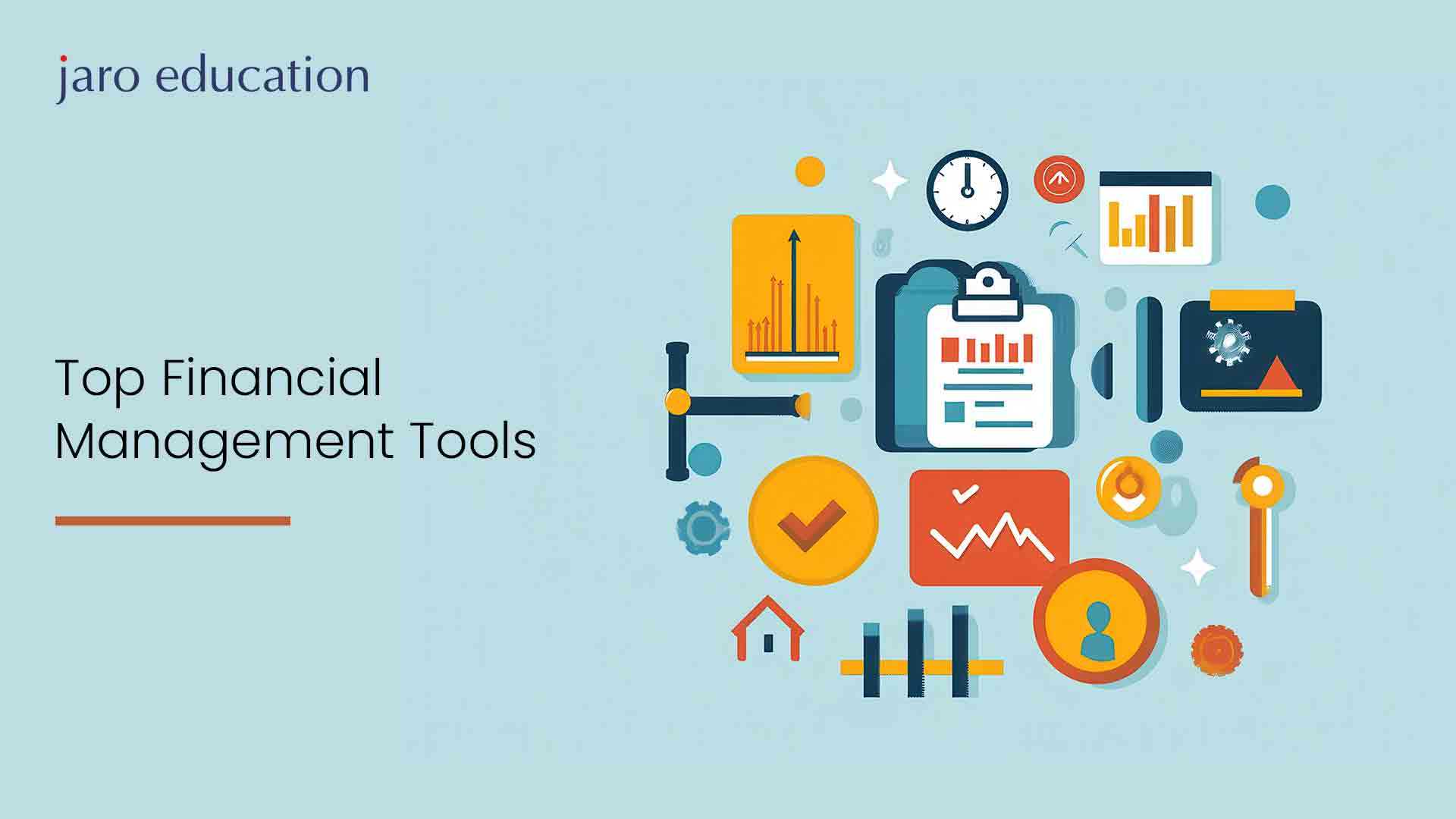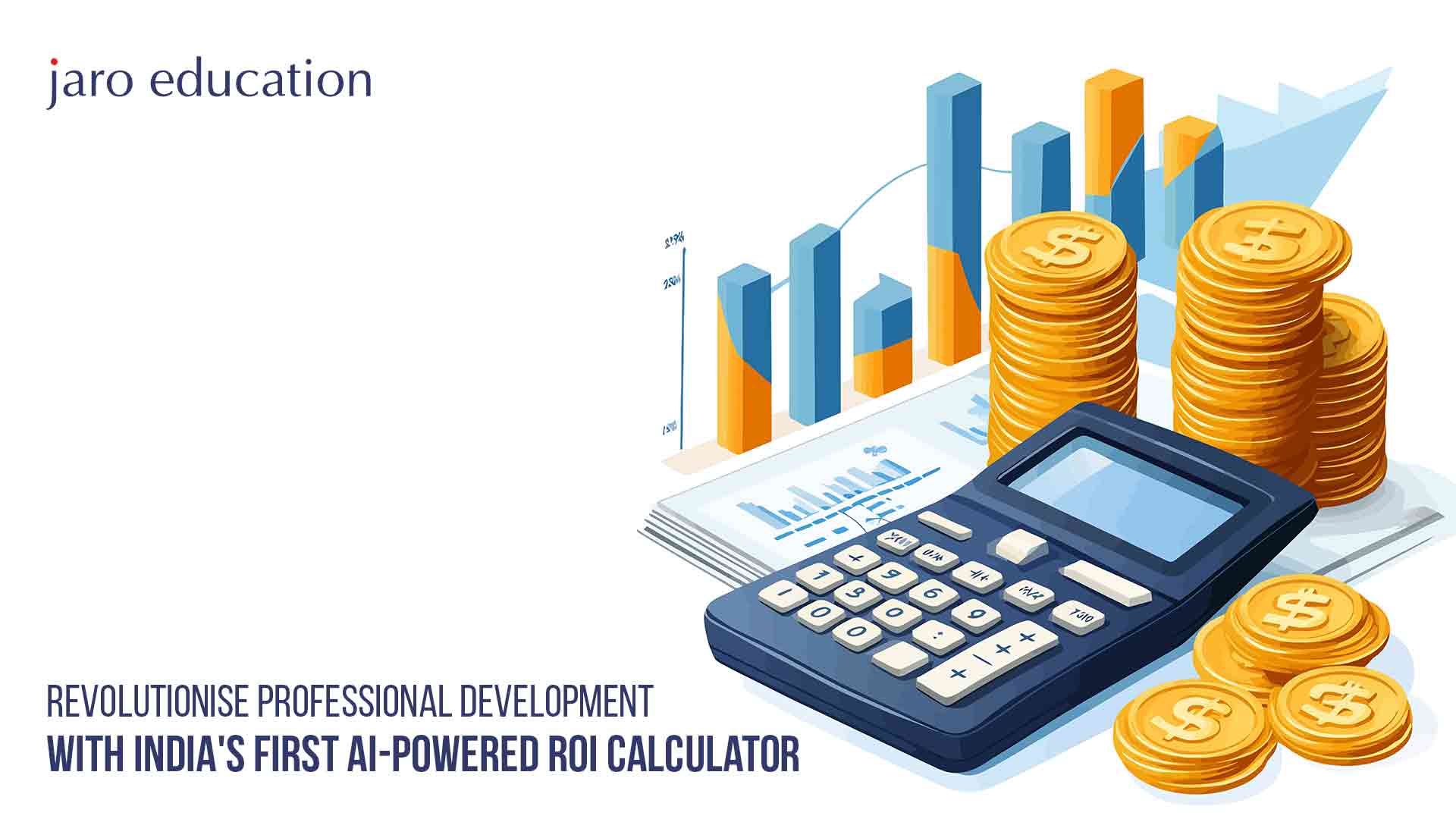Empower Your Career Shift: Know It All About Jaro Education's Skill Gap Calculator
Table of Contents

- jaro education
- 29, October 2024
- 5:00 pm
Meet Emily Chattopadhyay—a creative copywriter in the world of marketing who’s been eyeing a new path for some time now. While marketing has its rewards, Emily’s heart is set on something different: a career in Business Analysis or Human Resource Management, where she can blend her creative flair with a more data-driven, people-oriented role. However, she is still confused between her two target industries. Which industry are her skills suited to better? Which industry will be easier to transition to? The confusion is endless.
At a recent career event hosted by the Economic Times, Emily was introduced to two breakthrough AI tools brought to the market by Jaro Education, a leading online higher education and upskilling firm: the ROI Calculator and the Skill Gap Calculator. These tools turned her “someday” aspirations into an actionable plan:
- The ROI Calculator showed Emily the concrete potential of her career shift, including financial growth and learning commitments.
- The Skill Gap Calculator gave her a detailed roadmap to bridge her current skill set with the requirements of her target roles in her current industry as well as her target industries!
Here’s a snapshot of the ROI report that set Emily’s course:
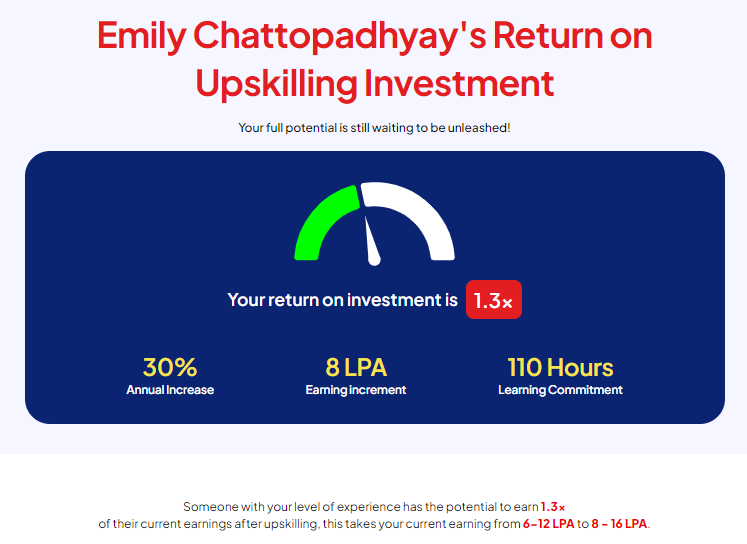
With these insights, Emily saw her goals clearly—a 1.3x return on her investment with a potential annual increase of 30% in earnings. The ROI Calculator even highlighted an 8 LPA earning increment and mapped out a realistic learning commitment of 110 hours, giving her confidence in the journey ahead.
Emily’s Industry Dilemma and Skills Gap
-
- Current Job Market Challenges: Marketing roles are evolving rapidly, and Emily sees that the skills valued in her current role won’t necessarily transfer to a career in BA or HR.
- The Skills Dilemma:
-
- Current Strengths: Creativity, brand strategy, and communication.
- Skills Gap: Technical skills like data analysis and HR fundamentals—critical for the roles she aspires to.
-
| Emily’s Skill Profile | Current Skills | Needed for BA/HR |
|---|---|---|
| Core Skills | Creative writing, brand strategy | Data analysis, project management |
| Soft Skills | Communication, creativity | Analytical thinking, negotiation |
| Technical Skills | Content marketing, SEO | Excel, SQL, HR principles |
The ROI Calculator sparked her motivation by revealing the concrete benefits, but she still needs clarity on how to bridge her skills gap in these target roles.
The Risk of Emily Ignoring Her Skills Gap
-
- Career Stagnation: Staying put without upskilling means Emily could miss out on the substantial 8 LPA increment and 30% annual growth potential her new field offers.
- Job Insecurity: Without taking steps to close her skills gap, Emily knows she might feel increasingly out of sync in an industry moving in a direction she no longer wants to follow.
- Emotional Toll: Knowing that her target roles offer strong ROI but lacking the immediate skills to secure them has left Emily feeling stuck and anxious about her future.
Overview of the Skill Gap Calculator
What is the Skill Gap Calculator? Jaro Education’s Skill Gap Calculator is a game-changer for Emily! This tool offers a detailed skill gap analysis, designed to pinpoint the exact skills she needs to successfully transition into her dream roles in Business Analysis or HR. It even reveals which industry (BA or HR) is easier for Emily to transition into, based on her existing skill set.
Purpose: With this tool, Emily can clearly see:
- Which skills she already has vs. what’s required in her target roles.
- A roadmap to bridge her skill gaps.
- Insights into industry-specific skill gaps, making it easy for Emily to target the industry that’s most compatible with her background.
Key Features and Functionalities of the Skill Gap Calculator
- AI-Enhanced Skill Gap Analysis: Emily receives a comprehensive gap score, highlighting her strengths and improvement areas, which are essential for her career transition.
- Industry Transition Guidance: The tool offers a targeted view of the core skills needed for BA and HR, helping Emily understand the exact knowledge she’ll need in each field.
- Personalized Reports: Emily’s report includes actionable insights with specific resources and course recommendations.
- Quick Assessment: It only takes a few minutes for Emily to complete the analysis, and she appreciates how easy it is to use.
- Expert Consultation: The tool provides a complimentary expert consultation, along with access to free resources, helping Emily start her journey with guidance.
Steps to Use the Skill Gap Calculator
Next, she naturally wondered how to perform a skill gap analysis. Here’s how Emily used the Skill Gap Calculator to understand her next career steps:
- Access the Tool: Emily logs into Jaro Education’s website and locates the Skill Gap Analysis section.
- Complete the Questionnaire: Emily answers the questions, outlining her current role, experience, and career goals. Her inputs include:
| Questionnaire Responses | Emily’s Answers |
|---|---|
| Current Job Field | Marketing |
| Years of Experience | Less than 1 year |
| Desired Career Fields | Business Analysis and HR |
| Top Marketable Soft Skills (Rate them on a scale of 5) | Time Management - 5, Interpersonal Skills - 5, Collaboration - 5, Curiosity - 5, Communication - 5 |
| Top Marketable Hard Skills (Rate them on a scale of 5) | Copywriting - 3, Content Creation - 5, Market Research - 3, SEO Basics - 5, Documentation Skills - 5 |
| Career Goals | Growth and role stability |
| Current Role Challenges | Limited alignment with long-term goals, technical skills for BA or HR |
3. Review Results: The report shows Emily her skill gaps for her current and target industries:
- Current Industry (Marketing): 52% soft skill gap, 35% hard skill gap
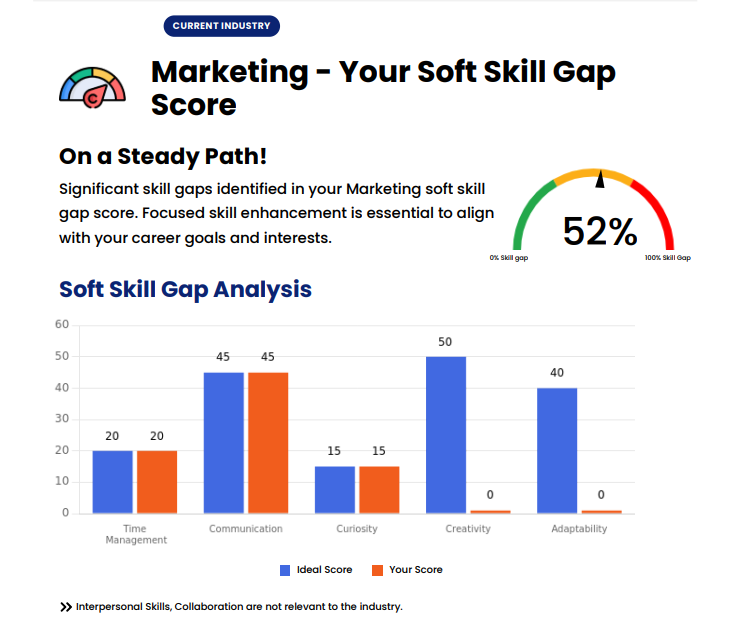
Based on Emily’s chosen soft skills and her ratings of those skills, the Skill Gap calculator presents a graphical representation of her soft skill gap based on the soft skills most needed in the Marketing industry. For example, her high rating and selection of time management, communication, and curiosity give her a positive score as these skills are relevant to the skills needed in the marketing industry. However, her skill gap lies within creativity and adaptability, which she did not select as her top soft skills. Additionally, the tool shows her that although interpersonal skills and collaboration may be important, they are not of UTMOST importance in the marketing industry!
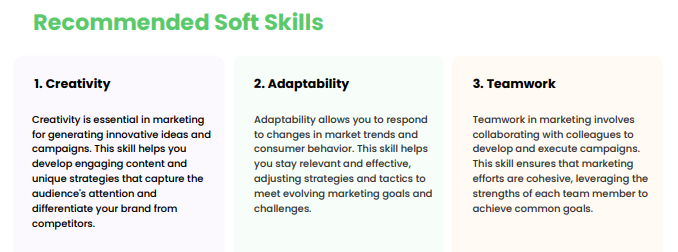
Next, the tool proceeds to recommend soft skills that are missing in Emily’s profile but may be impactful based on industry standards in the marketing industry. It also adds teamwork, which although isn’t one of the top 5 skills, still is important in the industry. It also explains how each skill matters in marketing!
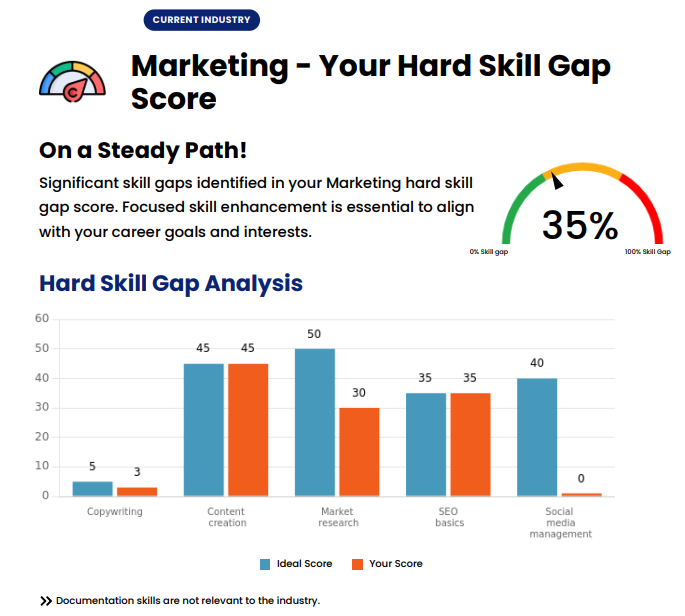
While soft skills may be transferrable, most hard skills are not. This is what makes them unique and important for each industry. Another important factor that the skill gap calculator considers is how important each skill (soft or hard) is, relative to the others. For example, market research might just be the most important hard skill in the marketing industry, which is why it has the highest height in the bar graph. Emily’s score is calculated not only based on the skills selected but also on the rating she gave herself out of 5.
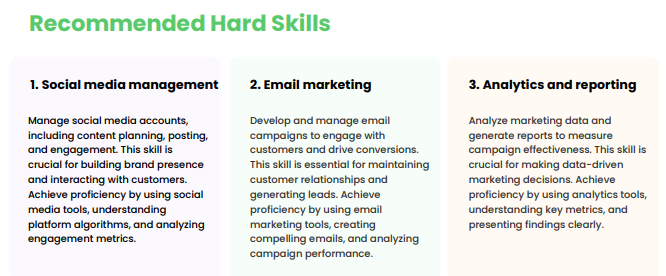
The recommended hard skills guide her towards excellence in her current industry and help her cover up the skill gap that might be holding her back in her current role in the marketing industry.
- HR Industry: 50% soft skill gap, 100% hard skill gap
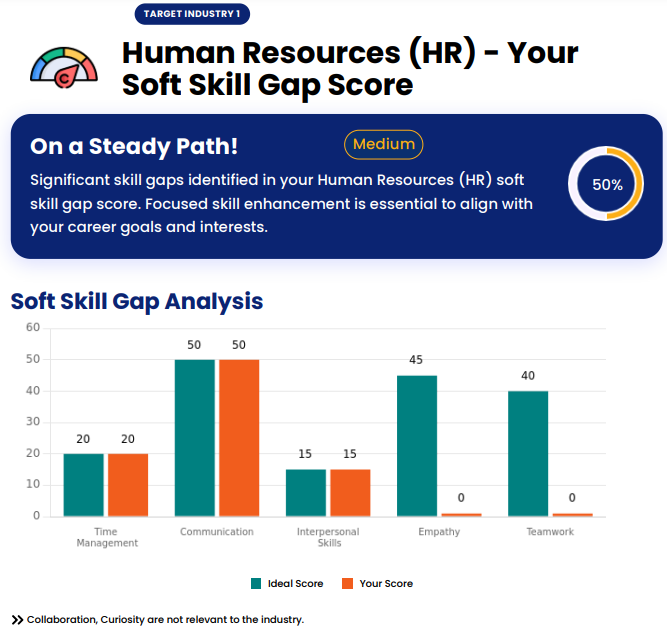
Next, the tool compares her soft skills to those needed in the HR industry. Luckily for her, three of these skills are transferrable!
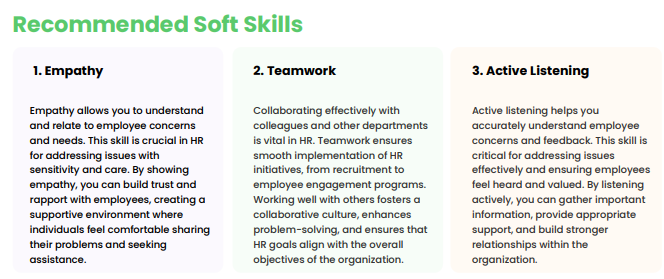
However, she still lacks essential soft skills like empathy and teamwork which she needs to build on if she wishes to transition to the HR industry.

When it comes to her hard skill report, it gives her a realistic picture of the fact that she isn’t very skilled when it comes to the hard skills essential to the HR domain, and neither are her marketing hard skills transferrable. Thus, there is a 100% skill gap when it comes to the top 5 marketable skills, even though she may have other hard skills that may be useful in the HR domain. However, the 5 skills most in demand for the HR industry were lacking. Alas.
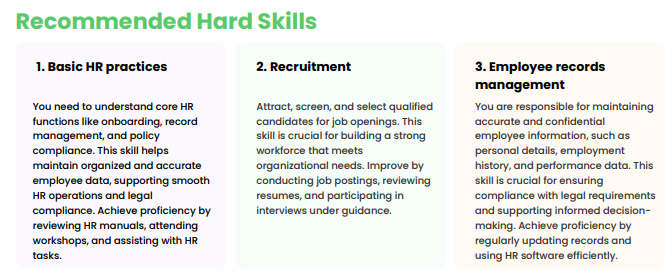
The tool recommends three hard skills important to the HR industry so that Emily can begin to close her skill gap if she wishes to.
- BA Industry: 59% soft skill gap, 85% hard skill gap
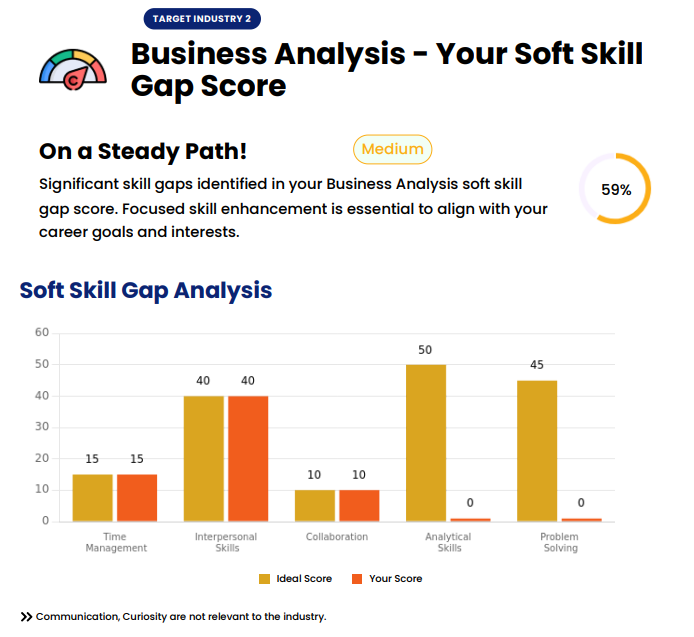
Emily moves on to her Business Analysis industry report before making a decision. Luckily, three of her soft skills transfer to the BA industry as well, and she has a high score on them! Her skill gap when it comes to analytical skills and problem-solving skills can be covered.

The recommended soft skills for the BA industry seem achievable to Emily, as she already has a keen sense of problem-solving and attention to detail, even though she didn’t choose them among her top 5 soft skills.
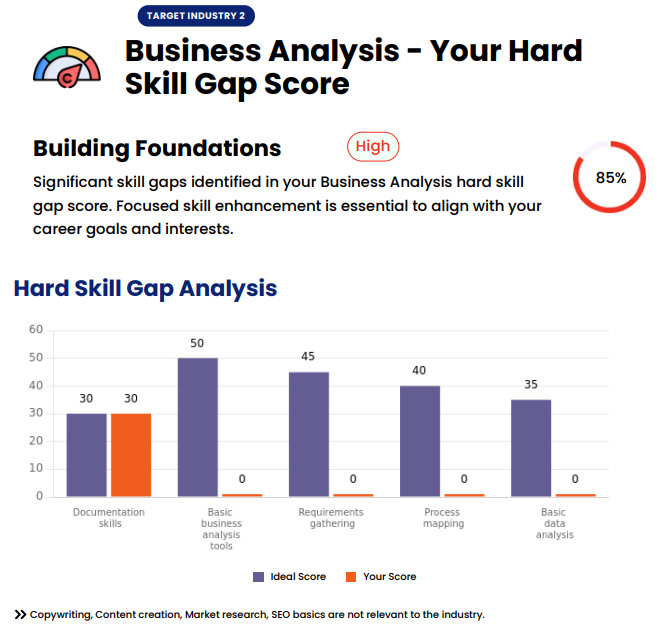
Again, as most hard skills aren’t transferrable, there is a significant hard skill gap noted in her results. However, luckily, being a copywriter, she’s good at documentation! She is happy to know that at least one of her skills is valued in the BA industry, which is one of her target industries.
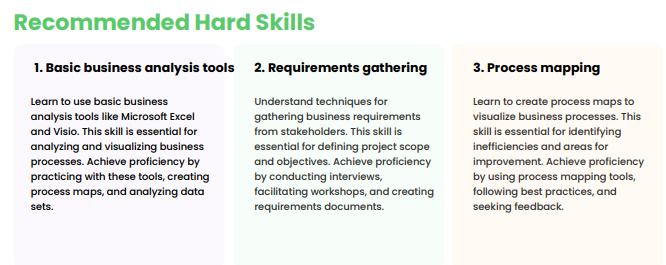
-
- Based on these insights, Emily identifies Business Analysis as a more achievable transition goal.
- Explore Recommendations: Emily decides to pursue the free counselling call with Jaro Education’s mentorship expert and receives tailored recommendations, including specific courses to close her gaps:
- Utilize Mentorship and Resources: Emily follows up with mentors and explores suggested courses. Additional free resources, like the “Python for Data Analysis” course by Jaro Education and other free courses and bootcamps provide her with a head start.
- Track Progress: Emily sets milestones to recheck her skills as she completes each recommended course, ensuring she stays on track to achieve her BA career goals.
Emily’s Journey to a New Career
By following the Skill Gap Calculator’s recommendations, Emily pursued a certification course of her choice and gradually acquired the skills she needed for Business Analysis. Within a few months, she transitioned from marketing to a BA role with a significant career hike, all while building a foundation of confidence and industry-relevant knowledge.
The Skill Gap Calculator offered Emily a structured, engaging pathway, with personalized insights that kept her motivated. Each milestone on her journey reinforced her commitment to reaching her goals, making the process not just educational but truly transformational.
Market Trends and Growth Potential: Why Emily’s Journey Matters
Emily’s path is a clear reflection of a larger workforce trend: many professionals are pivoting toward in-demand fields like Business Analysis and HR, which are currently seeing substantial growth and opportunity. This shift aligns with market demands, where data-driven decision-making and analytical skills are paramount.
Jaro Education is a leader in helping professionals achieve this pivot, providing tools like the Skill Gap Calculator that empower users to bridge the gap between their current capabilities and future career goals. With a strong focus on education and industry alignment, Jaro Education ensures that every learner is set up for success in their chosen field.
Conclusion
Inspired by her own journey, Emily encourages anyone considering a career shift to take the leap. Using Jaro Education’s Skill Gap Calculator, she believes that anyone can map out a clear, actionable path toward their career dreams.
Jaro Education remains dedicated to supporting professionals like Emily with tailored education solutions, practical tools, and personalized support. With resources like the Skill Gap Calculator, Jaro is committed to helping individuals thrive in today’s most promising and fast-growing industries.
For more information on how Jaro Education is shaping career growth, read the full press release.
Frequently Asked Questions
A skill gap refers to the difference between the skills an individual currently possesses and the skills required to succeed in a particular role or industry. It highlights the areas where additional training or upskilling is needed for someone to meet job expectations or advance in their career.
An example of a skills gap could be a marketing professional transitioning into a data analysis role. If they lack proficiency in tools like SQL or Python, which are essential for data analysis, this difference between the skills they have and the skills required for data analysis would be their skill gap.
To calculate a skill gap, identify:
-
- The required skills for the target role.
- The current skills the individual has.
Using this comparison, you can determine where gaps exist. Tools like Jaro Education’s Skill Gap Calculator can automate this process by assessing current skills and suggesting specific areas for improvement based on industry requirements.
A basic skills gap often refers to fundamental or foundational skills that are missing. This can include essential competencies like communication, time management, or basic computer skills, which are important for nearly all professional roles.




